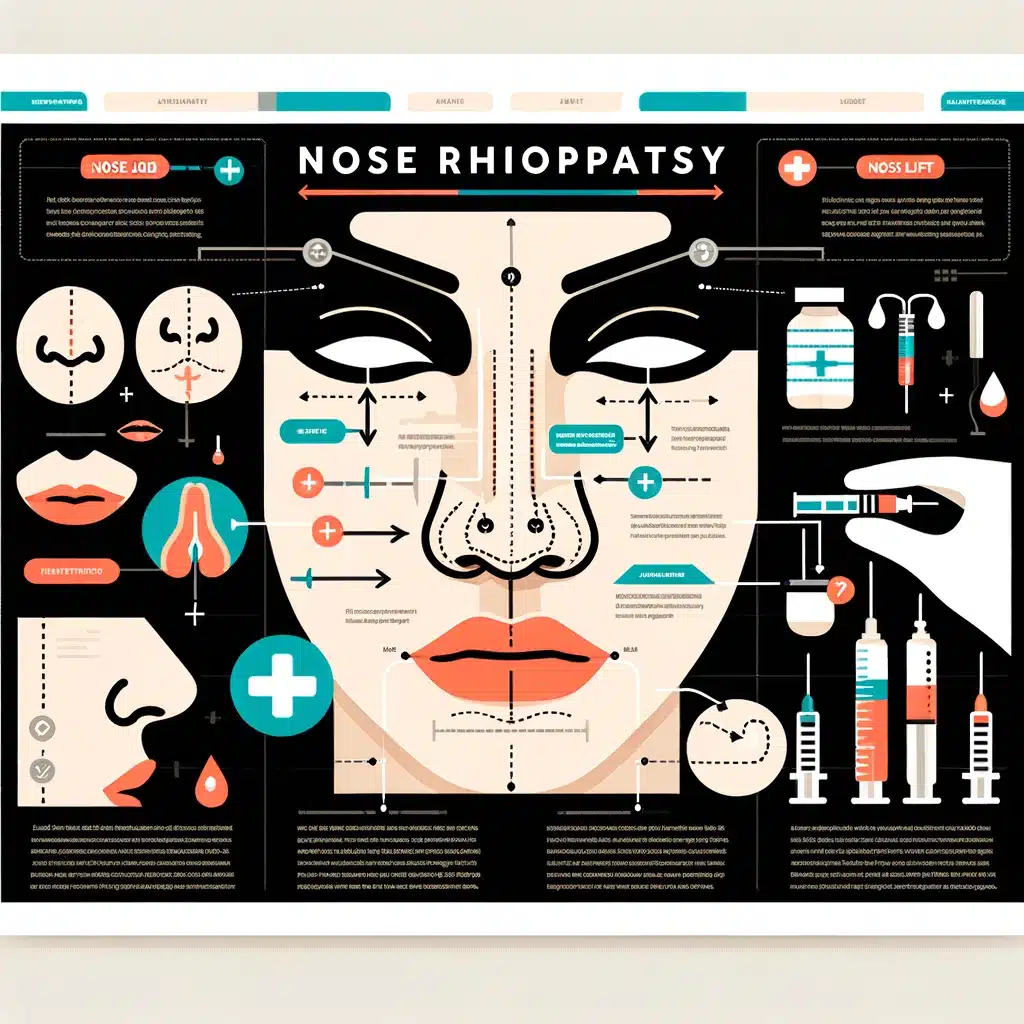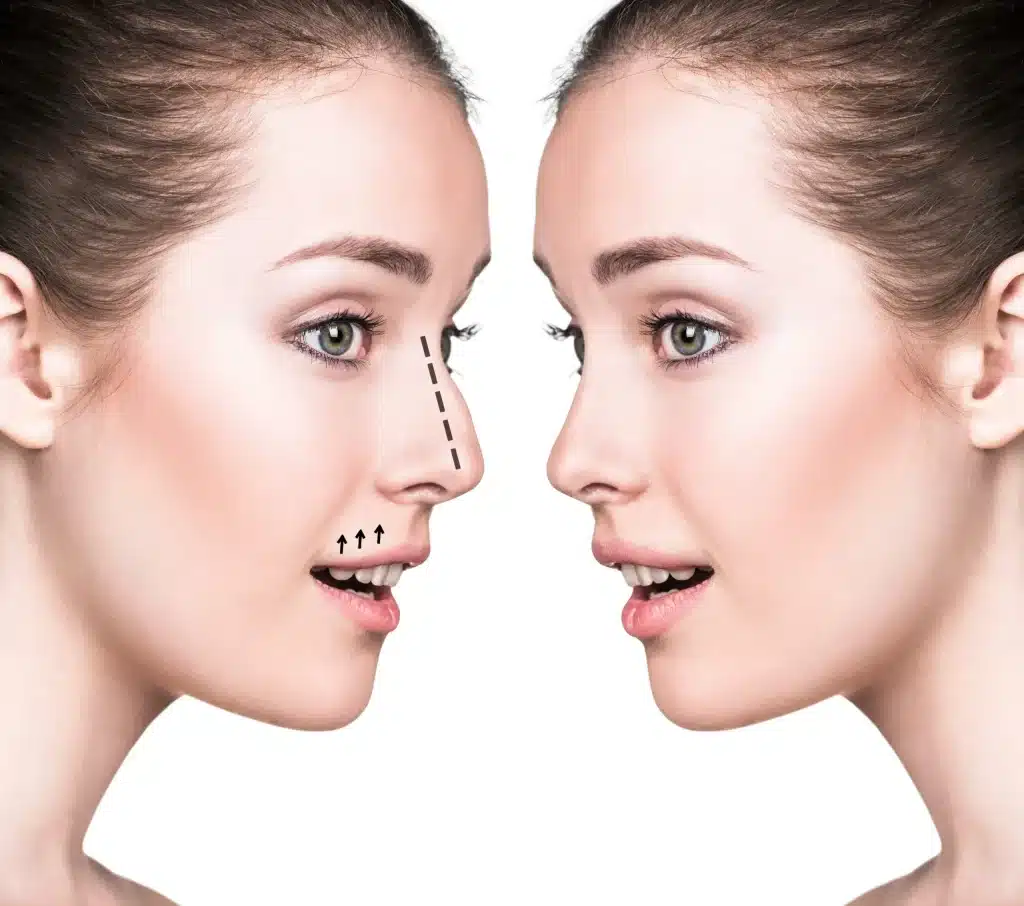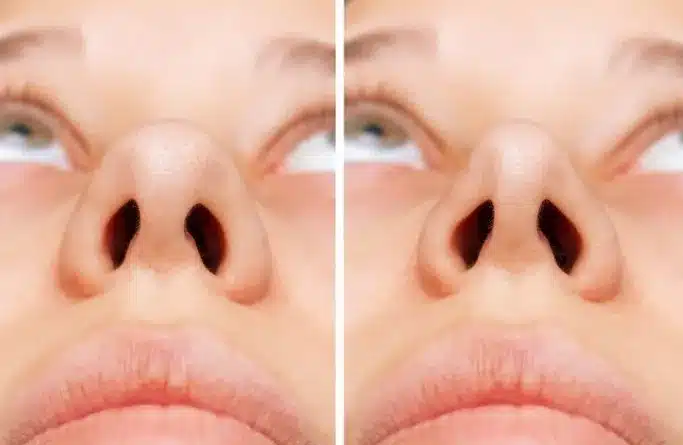Cosmetic surgery offers transformative options for individuals seeking aesthetic enhancements, including procedures like nose job and nose lift. These interventions, encompassing nasal reshaping and reconstruction, address both cosmetic concerns and functional issues such as septoplasty, which improves breathing by correcting nasal septum deviations. Whether for refining nasal appearance or enhancing breathing functionality, these procedures offer personalized solutions tailored to individual needs.
Definition of Nose Jobs
Rhinoplasty, colloquially known as a nose job, is a sophisticated surgical procedure that offers a wide range of alterations to the nose’s shape, size, and overall proportions. Undertaken for cosmetic and medical reasons, a nose job‘s primary goal is to provide a harmonious balance between the nose and other facial features, ensuring it complements the face’s aesthetics.
Moreover, from a medical perspective, it can rectify breathing difficulties linked to structural nasal problems or even correct deformities arising from trauma or inherent birth defects.
Rhinoplasty offers a transformative solution for individuals seeking to enhance their facial aesthetics by addressing concerns about their noses. Whether it’s a fleshy nose, a Roman nose, or a fantasy-inspired appearance, skilled surgeons can tailor the procedure to meet each patient’s unique desires.
Definition of Nose Lift
Diverging from the comprehensive changes a nose job offers, a nose lift has a more singular focus. This procedure chiefly concerns the elevation of the nose’s tip or the modification of the angle between the nose and the upper lip.
It targets those seeking specific changes to the nasal tip, for aesthetic desires or age-related sagging that sometimes occurs with the nasal tip.
Clinic contact number: +989371200167
Difference Between Nose Job and Nose Lift
Nose Job (Rhinoplasty)
A nose job, technically known as rhinoplasty, refers to a surgical procedure aimed at changing the shape, size, or proportions of the nose. This can be achieved by altering the nasal bones, cartilage, or both. Here are the main features:
Purpose
Rhinoplasty can be performed for a variety of reasons:
Cosmetic Reasons
To enhance the nose’s appearance by changing its shape, size, or angle.
Functional Reasons
To improve breathing difficulties caused by structural defects in the nose.
Reconstructive Reasons
To restore the shape of the nose after trauma or correct congenital malformations.
Scope
The procedure can address multiple areas of the nose:
- Reshaping the nasal tip
- Narrowing the nostrils
- Changing the angle between the nose and upper lip
- Straightening a crooked nose
- Adjusting the bridge
Techniques
There are two primary techniques used in rhinoplasty:
Open Rhinoplasty
Involves an incision made on the columella (the soft tissue between the nostrils). This allows the surgeon greater access to the nasal structures.
Closed Rhinoplasty
All incisions are made inside the nostrils, which means there are no visible scars post-surgery.

Nose Lift (Tip Rhinoplasty or Tipplasty)
A nose lift, often referred to as tip rhinoplasty or tipples, is a more specific procedure focusing primarily on the tip of the nose.
Purpose
The primary goals of a nose lift are:
Elevate a drooping nasal tip.
Refine a bulbous tip.
Reduce the size or change the shape of the nostrils.
Modify the angle between the nose and upper lip.
Scope
This procedure is more localized, addressing mainly the nasal tip and, occasionally, the nostrils.
Technique
Typically, it involves fewer and smaller incisions compared to a full rhinoplasty. The approach might be open or closed, depending on the specific needs of the patient and the surgeon’s preference.

How Nose Job and Nose Lift Can Complement Each Other
Often, patients might choose to undergo both a nose job and nose lift. For example, one might want a change in the bridge of the nose (handled by a nose job) and simultaneously wish for an elevated tip (achieved via a nose lift). Both procedures can give a harmonious and comprehensive result, addressing the entire nose.
The Roman nose, characterized by its famous bridge and downward-curved tip, is a distinctive facial feature that may cause individuals to consider a nose job for enhancement. In this article, we will explore the intricacies of nose jobs tailored explicitly to the Roman nose.
Clinic contact number: +989371200167
Age Criteria for Nose Job and Nose Lift
It’s advised to wait until the nose reaches its full growth before considering a nose job and nose lift. Typically, this age is around 15-16 for girls and a bit later for boys. However, there can be exceptions, especially for medical reasons like correcting breathing issues.
If you smoke or vape, stop. Smoking and vaping can slow healing after surgery and can result in tissue death. You could also get an infection. Mayo Clinic
Benefits of a Nose Job and Nose Lift
- Improved Confidence: Enhancing one’s nose can bring about a dramatic boost in self-confidence.
- Breathing Ease: A nose job can rectify structural abnormalities causing breathing issues.
- Facial Symmetry: Both procedures can ensure a more symmetrical face.
- Correct Birth Defects: Congenital issues can be addressed.
- Post-trauma Restoration: Return to pre-injury looks after an accident.
- Enhanced Aesthetic Appeal: A defined nose enhances facial aesthetics.
- Professional Reasons: Some choose these for their careers, especially in show business.
- Anti-aging: A nose lift can provide a younger appearance.
- Sinus Relief: Rhinoplasty can sometimes help in addressing chronic sinusitis.
- Improved First Impressions: Given the centrality of the nose, it plays a role in first impressions.
before undergoing the procedure, you should be well-acquainted with the difference between a nose job and nose lift.
Risks of a Nose Job and Nose Lift
- Infection: Like any surgery, there’s always an infection risk.
- Anesthesia Complications: Reactions can occur from anesthesia.
- Breathing Difficulties: Some might find it harder to breathe post-surgery.
- Nasal Septal Perforation: A hole in the nasal septum can develop.
- Poor Aesthetic Outcome: Results might not meet expectations after a nose job and nose lift.
- Chronic Nosebleeds: after a nose job and nose lift Some patients experience frequent nosebleeds.
- Scarring: Especially with open procedures.
- Numbness: Sensation loss in the nasal region.
- Swelling: Lasting swelling or puffiness.
- Revision Surgery: If the results aren’t satisfactory.
-
What Is The Downtime?
There is very little downtime following your procedure. Physically you will be able to carry on with your day-to-day living but there are some things you’ll need to be mindful of;
- You will need to avoid strenuous exercise for 48 hours
- Do not touch the area around your nose thread lift. Facials and facial massage should be avoided for 10 days following treatment.
- Don’t apply make-up to the area for at least 12 hours to give your skin time to settle.
- Avoid alcohol and smoking for 7 days as these can inhibit your skin’s healing response.
- Avoid direct sunlight and always wear an SPF 30.

RHINOPLASTY PROS AND CONS
Rhinoplasty, commonly known as a nose job, offers numerous potential benefits for individuals seeking to enhance the appearance of their nose. One of the primary pros of rhinoplasty is the ability to achieve a more balanced and aesthetically pleasing nasal appearance. By reshaping the nasal bones and cartilage, refining the nasal tip, or correcting asymmetry, rhinoplasty can help improve facial harmony and boost self-confidence. Additionally, rhinoplasty can address functional concerns such as breathing difficulties or nasal obstruction, leading to improved overall nasal function and quality of life for some patients.
With advancements in surgical techniques and technology, rhinoplasty can often provide long-lasting results that enhance both the appearance and function of the nose. However, rhinoplasty also comes with potential drawbacks and risks that individuals should carefully consider before undergoing surgery. One of the main cons of rhinoplasty is the possibility of dissatisfaction with the results. Achieving the desired outcome from rhinoplasty requires clear communication between the patient and surgeon, realistic expectations, and a thorough understanding of the limitations of the procedure.
Additionally, rhinoplasty is a surgical procedure that carries inherent risks, such as infection, bleeding, anesthesia complications, and poor wound healing. While these risks are relatively rare, they can occur, and it’s essential for individuals to weigh the potential benefits against the risks before proceeding with surgery. Another consideration with rhinoplasty is the recovery process, which can vary depending on the extent of the procedure and individual healing factors.
Following rhinoplasty, patients can expect swelling, bruising, and discomfort around the nasal area, which may persist for several weeks. Recovery from rhinoplasty requires patience and dedication to post-operative care instructions, such as avoiding strenuous activities, wearing a nasal splint or dressing, and attending follow-up appointments with the surgeon. While most patients are pleased with the final results of rhinoplasty, it’s essential to understand that the full outcome may take several months to manifest as swelling subsides and the nasal tissues settle into their new shape.
Renowned Institutions and Leading Figures
Nose job procedures, medically referred to as rhinoplasty, have witnessed significant advancements thanks to contributions from esteemed institutions and specialists in the field. Prominent universities such as Johns Hopkins University and the University of Miami have been at the forefront of research and development in rhinoplasty techniques, contributing to the understanding and execution of these complex procedures.
Dr. Rod J. Rohrich from the Dallas Plastic Surgery Institute is notably one of the leading figures in rhinoplasty, having published extensive research and developed innovative techniques that have shaped the practice worldwide. The most active company in this realm is arguably the Mayo Clinic, renowned for its comprehensive cosmetic surgery services, including nose jobs, which combines state-of-the-art techniques with personalized care, ensuring high satisfaction rates among patients. Recent statistics indicate a rising trend in rhinoplasty procedures, with over 220,000 procedures performed in the United States in the last year alone, highlighting the procedure’s growing acceptance and the continuous improvement in surgical outcomes.
Similarly, the practice of nose lifting, or tip rhinoplasty, has seen remarkable contributions from surgeons and institutions, refining techniques to enhance the nasal profile with less invasive methods. The Cleveland Clinic stands out as a leading hospital for cosmetic nasal surgeries, offering advanced nose lift procedures that cater to the individual needs of patients, ensuring minimal downtime and natural-looking results.
Surgeons like Dr. Bahman Gayron, based in Cleveland, have significantly influenced the field with pioneering research on nasal tip dynamics, contributing to the broader understanding of aesthetic nasal surgery. The American Society of Plastic Surgeons reports a steady increase in the demand for nose lift surgeries, with data showing that such procedures have become more popular by nearly 5% annually over the past few years. This growth is reflective of the advancements in surgical techniques and the increasing desire for refined and subtle aesthetic enhancements, pushing the boundaries of cosmetic nasal surgery.

Priyanka Chopra Just Revealed That a Botched Nose Surgery
Priyanka Chopra is opening up about the devastating effect a nose surgery gone wrong had on her mental health early in her career. The 40-year-old actress and star of Citadel and of the upcoming rom-com Love Again first detailed the experience in her 2021 memoir, Unfinished. In 2001, following the advice of a doctor, she underwent what was expected to be a routine surgery to remove a polyp in her nasal cavity—but the procedure went horribly awry.
“While shaving off the polyp, the doctor also accidentally shaved the bridge of my nose and the bridge collapsed. When it was time to remove the bandages and the condition of my nose was revealed, mom and I were horrified. My original nose was gone. My face looked completely different. I wasn’t me anymore,” she wrote. According to Dr. Mark Albert, a board-certified plastic surgeon in New York City, this is an extremely uncommon and strange scenario; he notes that the removal of a polyp (a noncancerous growth of excess tissue) and a rhinoplasty are two very separate and different procedures.
“A polyp is usually removed from the mucosa of the airway. Typically, the skin is not lifted up and changes are not made to the structure of the nose itself,” he explains. “This procedure is usually performed by ENTs and normally does not change the shape or appearance of the nose,” he adds. Dr. Ari Hoschander, a board-certified plastic surgeon in Rockville Centre, New York, agrees: “A polyp removal should not change the look of the nose,” adding that he doesn’t even perform this type of surgery.
Clinic contact number: +989371200167
Summary
In conclusion, nose job and nose lift surgeries offer multifaceted solutions for individuals seeking to refine both the aesthetic appearance and functional aspects of their noses. Nasal reshaping, a cornerstone of these procedures, addresses cosmetic concerns by sculpting the nose to achieve desired proportions and contours. Simultaneously, functional concerns such as septoplasty and nasal reconstruction play pivotal roles in enhancing breathing functionality and correcting structural irregularities. Furthermore, the advent of advanced techniques like functional rhinoplasty ensures that patients not only achieve their desired cosmetic outcomes but also experience improved nasal function post-procedure.
As cosmetic nasal surgeries continue to evolve, the spectrum of options within nasal cosmetic procedures broadens, offering patients a comprehensive array of choices tailored to their unique needs and goals. Whether through subtle refinements or more dramatic transformations, these procedures empower individuals to enhance their self-confidence and quality of life by harmonizing the aesthetic and functional aspects of their noses. Ultimately, nose job and nose lift surgeries represent not just physical transformations but also opportunities for individuals to embrace their ideal self-image with newfound assurance and satisfaction.
FAQs
- Is combining a nose job and a nose lift a good idea?
Combining both procedures can offer a comprehensive and balanced result depending on individual aesthetic goals.
2. Can I opt for a nose lift after having had a nose job?
Absolutely. However, consulting with a cosmetic surgeon for a detailed evaluation is crucial.
3. What is the difference between a nose job and a nose lift?
– A nose job, also known as rhinoplasty, is a surgical procedure aimed at reshaping and enhancing the appearance of the nose. It can involve various techniques to address issues such as a crooked nose, bumps on the bridge, or a bulbous tip. On the other hand, a nose lift typically refers to a non-surgical procedure, often performed using dermal fillers, to temporarily alter the appearance of the nose. Nose lifts are commonly used to address concerns such as a drooping nasal tip or mild asymmetry without the need for surgery.
4. What does a nose job entail?
– A nose job, or rhinoplasty, can be performed using either an open or closed technique, depending on the specific goals and preferences of the patient. During the procedure, the surgeon may reshape the nasal bones and cartilage, refine the nasal tip, or adjust the nostrils to achieve a more balanced and aesthetically pleasing appearance. Rhinoplasty is a surgical procedure that typically requires anesthesia and involves a recovery period of several weeks to months.
5. How does a nose lift differ from a nose job in terms of procedure and recovery?
– A nose lift, often performed using dermal fillers such as hyaluronic acid, is a non-surgical procedure that can be completed in a short office visit. The filler is strategically injected into specific areas of the nose to add volume, lift the nasal tip, or improve symmetry. Since nose lifts are non-surgical, there is minimal downtime, and most patients can resume normal activities immediately after the procedure. However, the results are temporary and typically last for several months to a year, depending on the type of filler used.
6. Which option is best for me: a nose job or a nose lift?
– The choice between a nose job and a nose lift depends on various factors, including your aesthetic goals, the specific concerns you wish to address, and your preference for surgical or non-surgical interventions. A consultation with a qualified facial plastic surgeon or dermatologist can help determine the most suitable option for your individual needs and goals. They can assess your nasal anatomy, discuss your treatment options, and provide personalized recommendations to help you achieve the desired outcome.
Rhinoplasty – Mayo Clinic
Nose Thread Lift: Everything You Need to Know About It (elite-aesthetics.co.uk)




